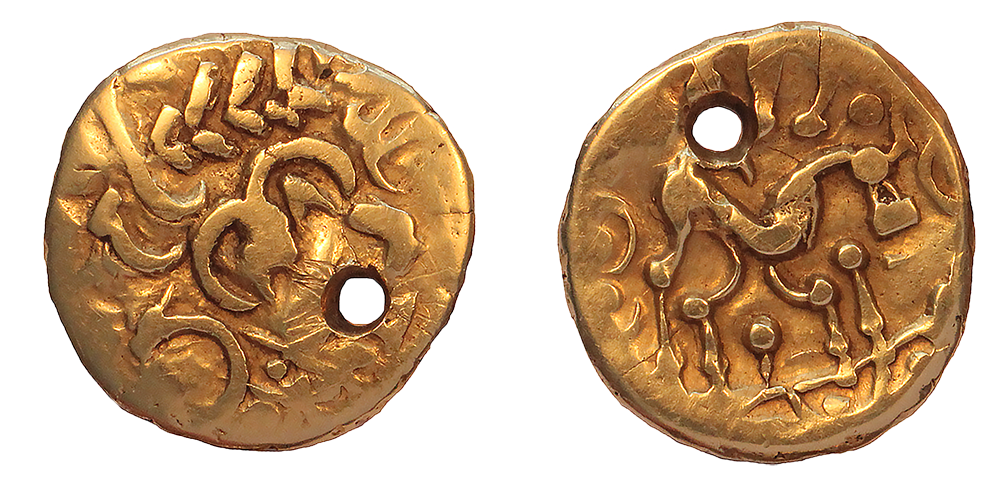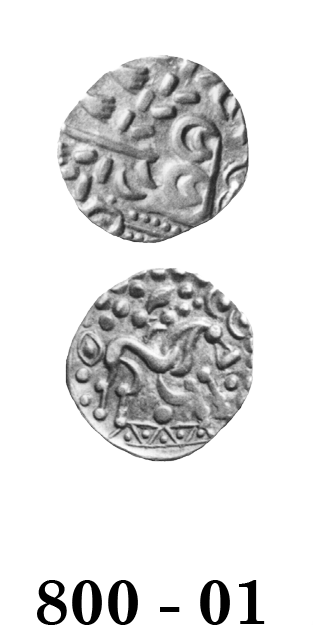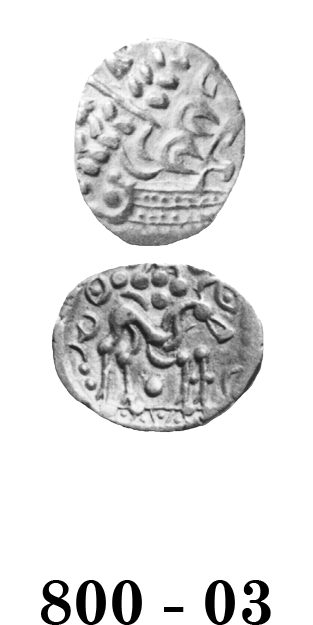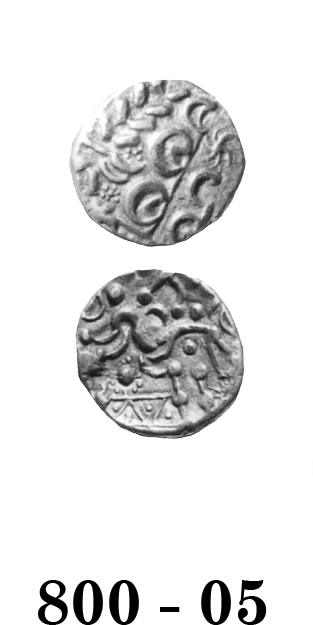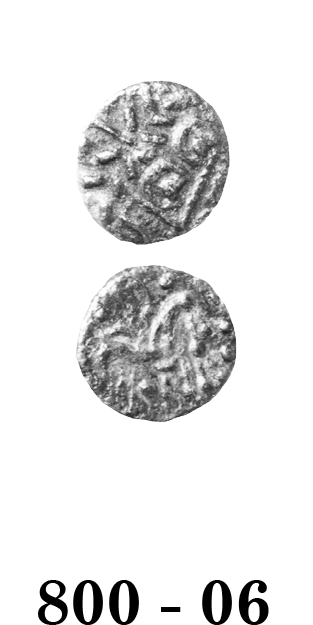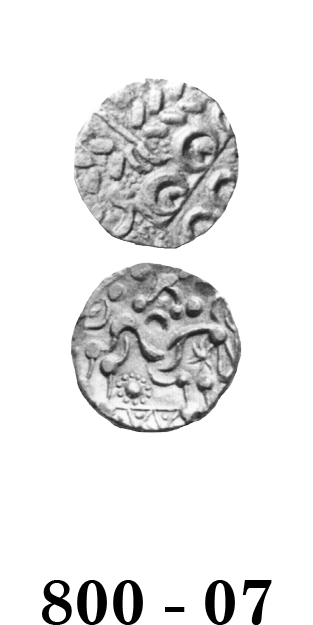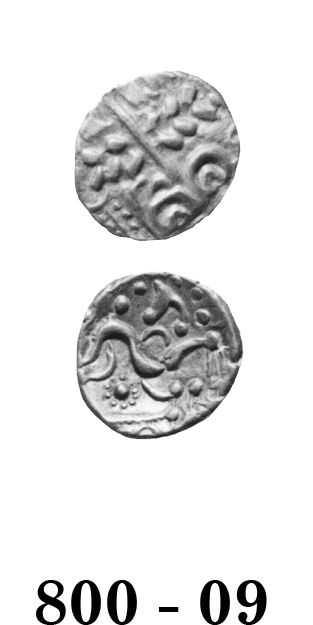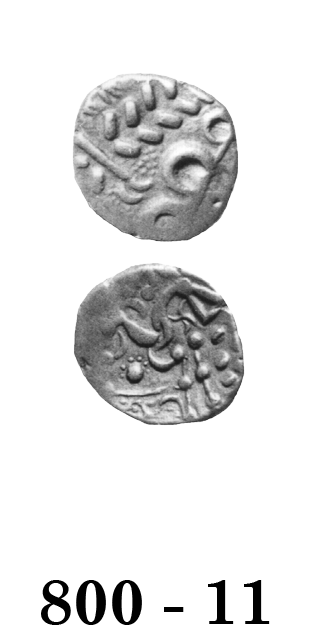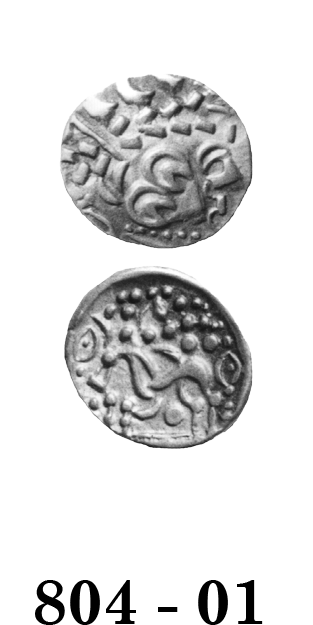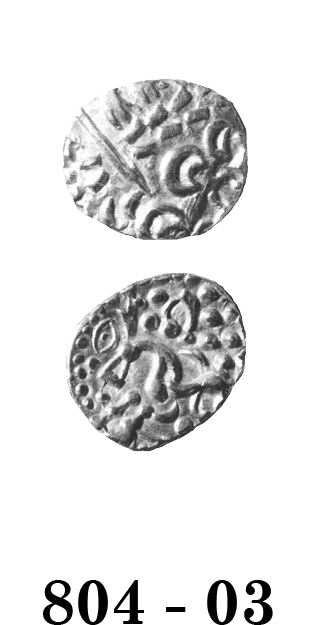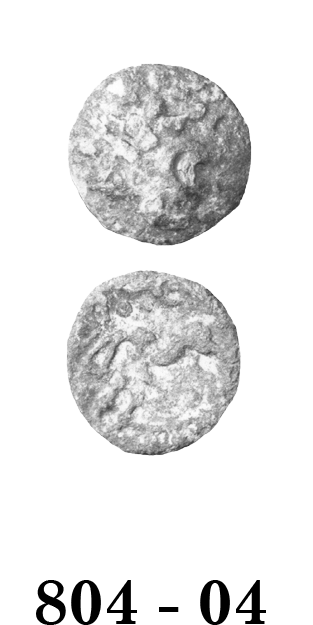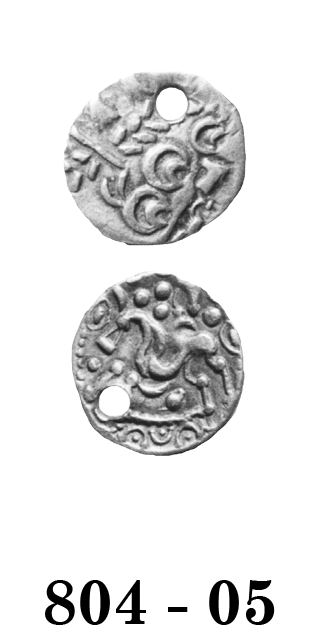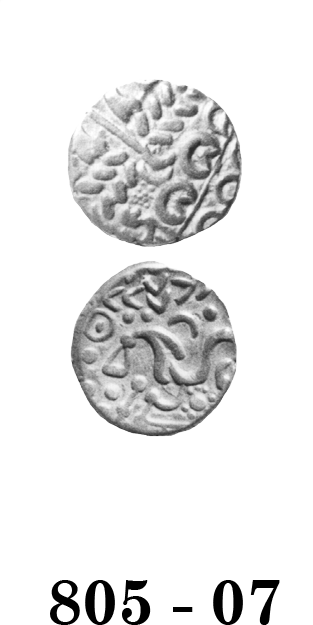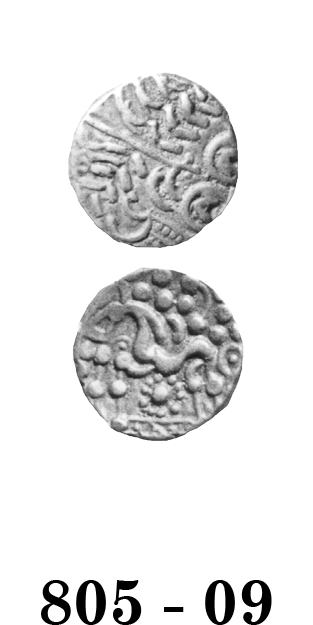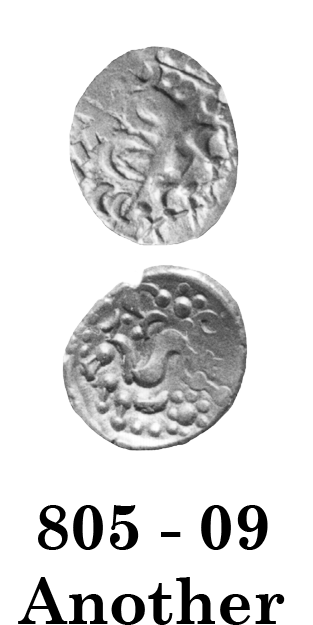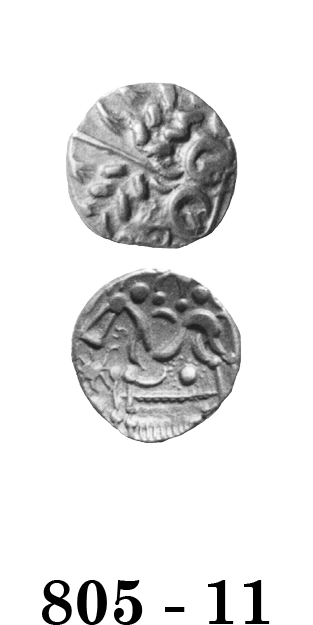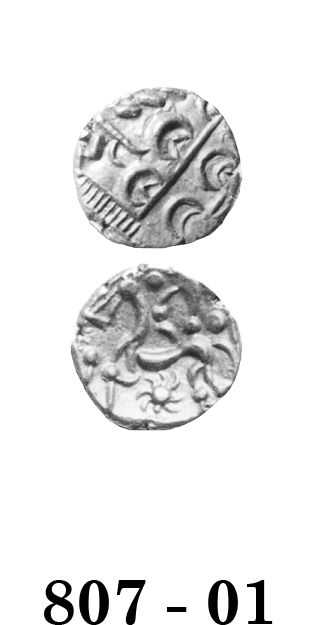
Celtic Coinage of Britain
third edition
Click on coin to see hidden information
The Corieltauvian Uninscribed Coinage
The North East Coast Type staters were the first coins to appear in the tribal area with any frequency. Either few coins were imported prior to 55 B.C. or those that had been imported were systematically withdrawn for recoining. The weight ranges given indicate the weights exhibited by typical examples today, the standard weights are given abo
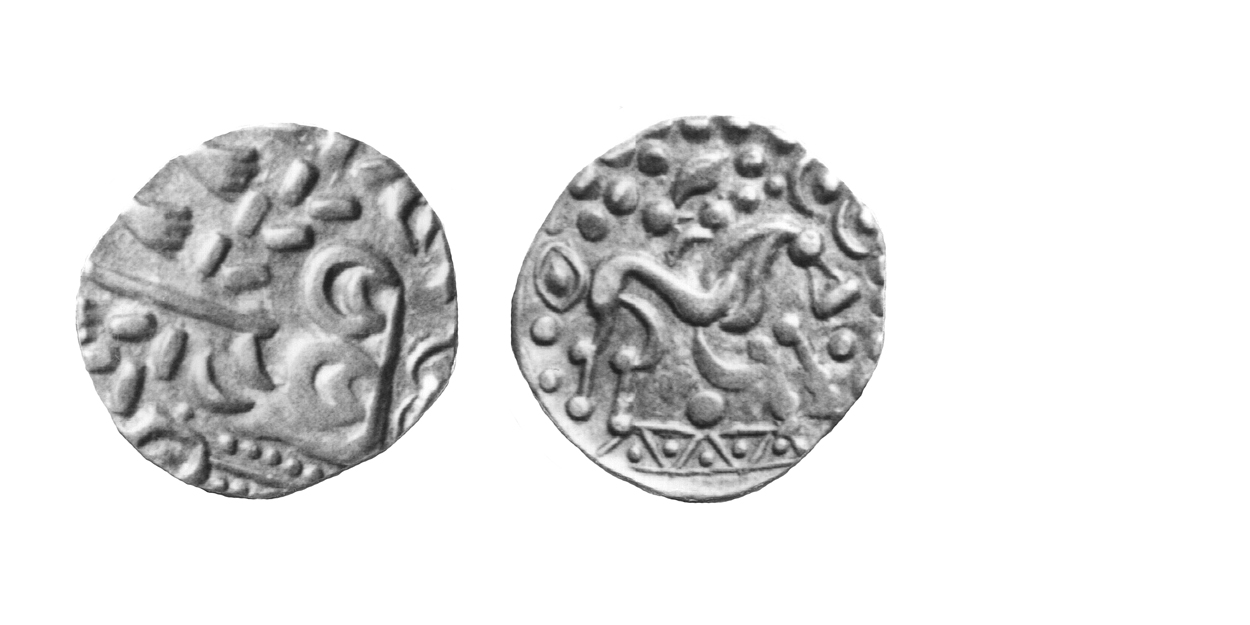
800 - 01 North East Coast Type
ca. 55 B.C. Very Rare
Gold Stater 5.7-6.4 gms. 20 mm
Earliest Record: Evans, 1864
OBV: Abstracted head of Apollo right
Identifying points:
1) spike with two crescents
2) diagonal linear depression to right of curls
3) stylized "yoke" to right of linear depression
4) curls almost circles, as opposed to crescents
5) wreath: leaves inwards
REV: Disjointed horse right
Identifying points:
1) pellet below horse
2) "coffee bean" behind horse
3) horse has ear made up of one crescent
4) two parallel exergual lines with zig-zag-and-pellets pattern between
5) horse's neck made up of two curves
CLASSIFICATION: Corieltauvian A
NOTES:
- Some in museums
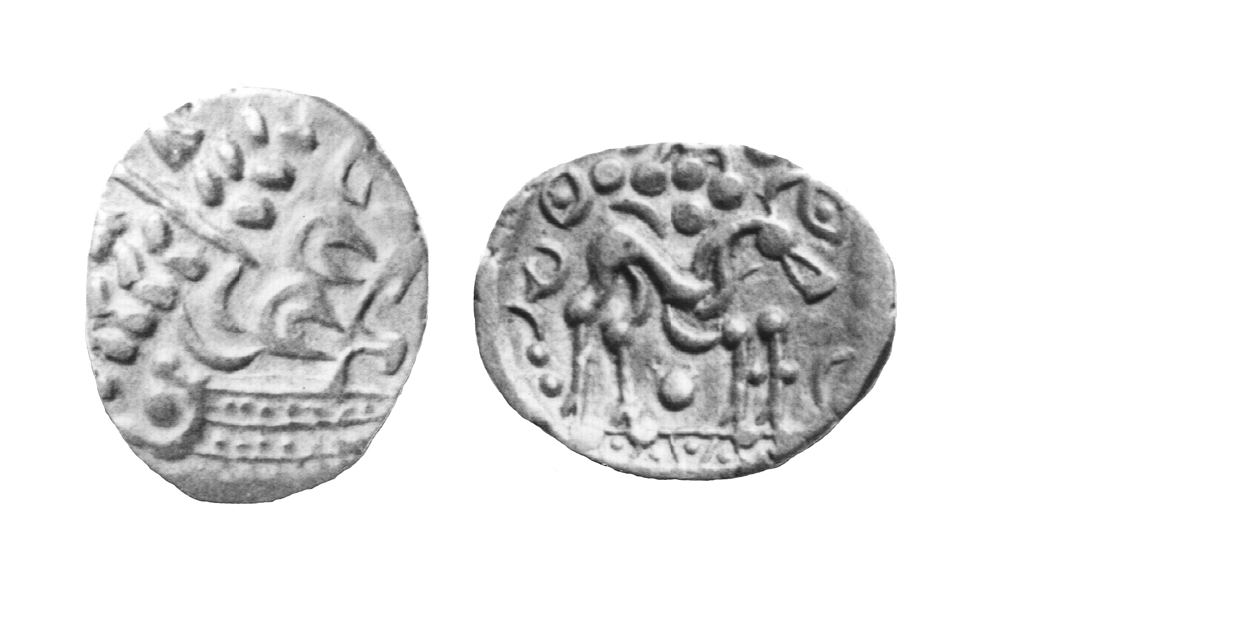
800 - 03 North East Coast Type
ca. 55 B.C. Very Rare
Gold Stater 5.7-6.4 gms. 21 mm
Earliest Record: Evans, 1864
OBV: Abstracted head of Apollo right
Identifying points:
1) spike with two crescents
2) no diagonal linear depression to right of curls
3) curls are more tear-shaped than circular
4) "yoke" before curls is made up of pellet with two arms
5) wreath: leaves downwards
REV: Disjointed horse right
Identifying points:
1) pellet below horse
2) horse has ear made up of one crescent
3) "coffee bean" in front of and behind horse
4) horse's neck made up of two curves
5) two parallel exergual lines with zig-zag-and-pellets pattern between
CLASSIFICATION: Corieltauvian A
NOTES:
- Some in museums
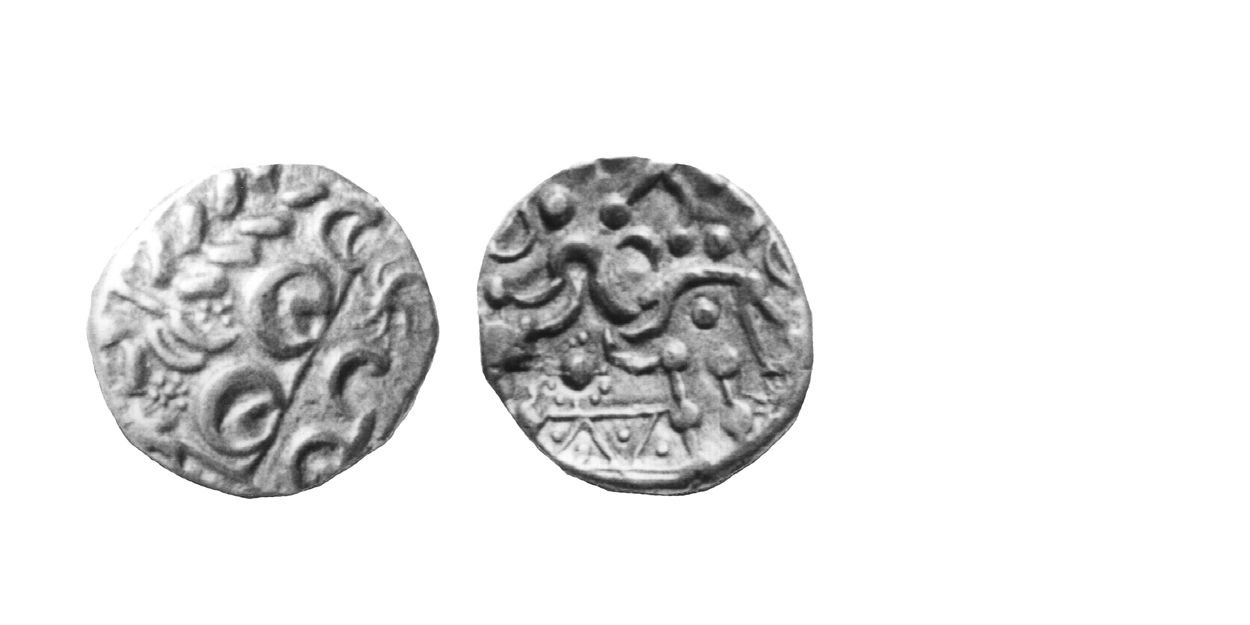
800 - 05 North East Coast Type
ca. 55 B.C. Very Rare
Gold Stater 5.7-6.4 gms. 18 mm
Earliest Record: Evans, 1864
OBV: Abstracted head of Apollo right
Identifying points:
1) spike with two crescents
2) diagonal linear depression to right of curls
3) stylized "yoke" to right of linear depression
3) curls almost circles, as opposed to crescents
4) spiral to right of curls
5) small pellets near crescents and spike
6) wreath: leaves inwards
REV: Disjointed horse right
Identifying points:
1) pellet below horse's neck
2) horse's neck made up of two curves
3) "coffee bean" behind horse
4) sunflower below horse
5) two parallel exergual lines with zig-zag-and-pellets pattern between
CLASSIFICATION: Corieltauvian A
NOTES:
- Some in museums
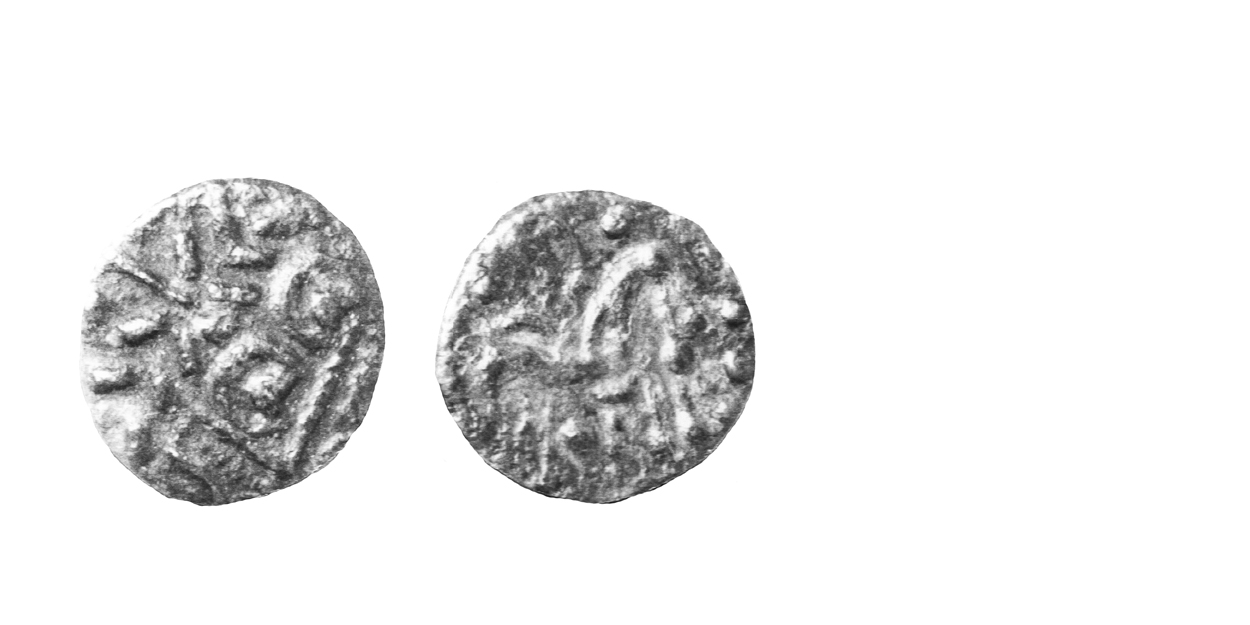
800 - 06 East Coast Type
ca. 55 B.C. Extremely Rare
Gold/Bronze Plated Stater ca. 3.4 gms. 18 mm
Earliest Record: Van Arsdell, 1989
OBV: Abstracted head of Apollo right
Identifying points:
1) as 800 - 05
REV: Disjointed horse right
Identifying points:
1) as 800 - 05
CLASSIFICATION: Corieltauvian A
NOTES:
- Ancient forgery of 800 - 05
- Originally covered with gold foil
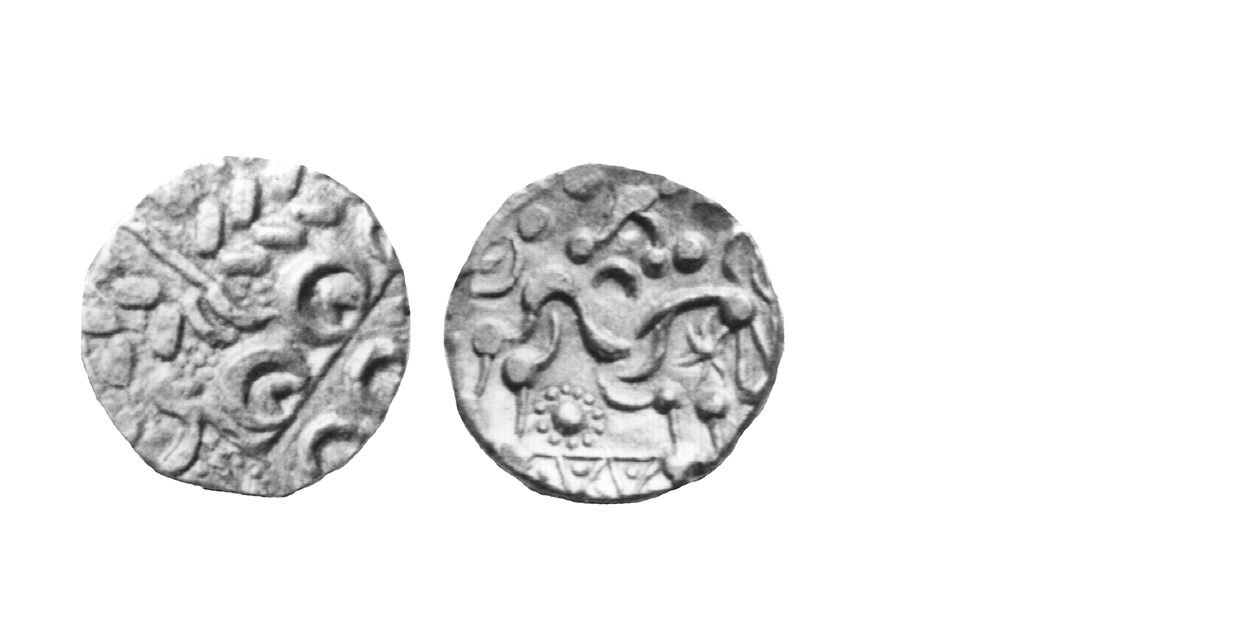
800 - 07 North East Coast Type
ca. 55 B.C. Very Rare
Gold Stater 5.6-6.4 gms. 18 mm
Earliest Record: Evans, 1864
OBV: Abstracted head of Apollo right
Identifying points:
1) spike with two crescents
2) diagonal linear depression to right of curls
3) stylized "yoke" to right of linear depression
4) small pallets near crescents and spike
5) curls almost circles, as opposed to crescents
6) wreath: leaves inwards
REV: Disjointed horse right
Identifying points:
1) six-armed spiral below horse's neck
2) horse's neck made up of two curves
3) "coffee bean" behind horse
4) sunflower below horse
5) two parallel exergual lines with zig-zag-and-pellets pattern between
CLASSlFlCATlON: Corieltauvian A
NOTES:
- Some in museums
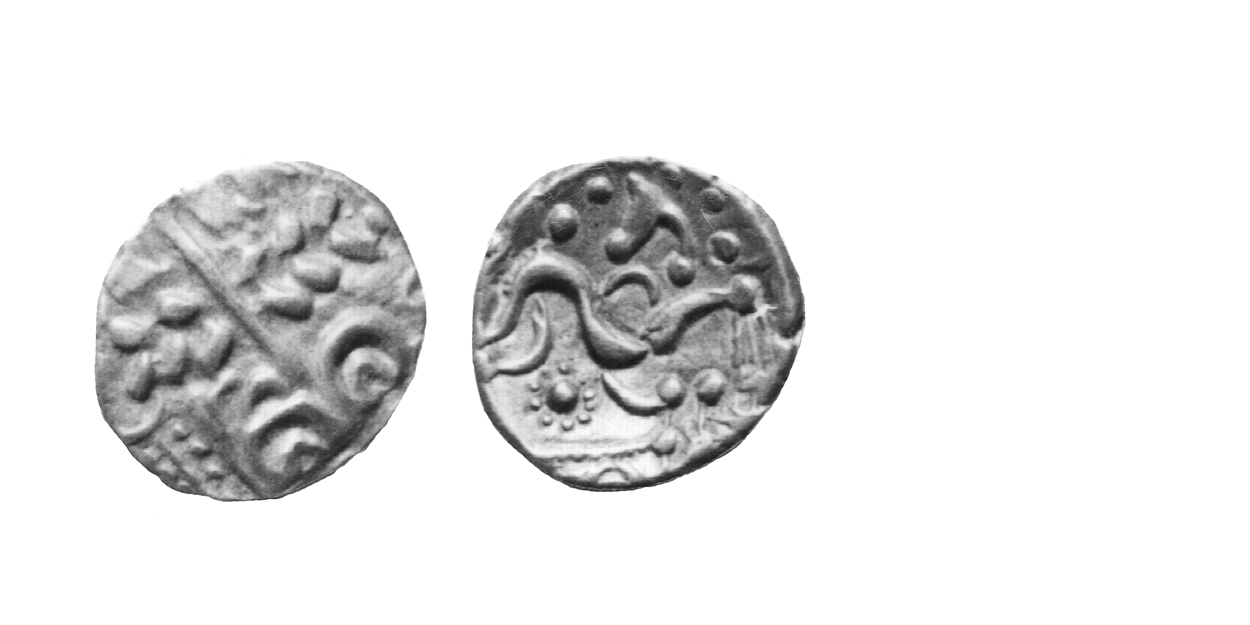
800 - 09 North East Coast Type
ca. 55 B.C. Very Rare
Gold Stater 5.7 6.4 gms. 18 mm
Earliest Record: Van Arsdell, 1989
OBV: Abstracted head of Apollo right
Identifying points:
1) as 800 - 05, but lacks the small pellets
REV: Disjointed horse right
Identifying points:
1) as 800 - 05
CLASSIFCATION: Corieltauvian A
NOTES:
- Most in museums
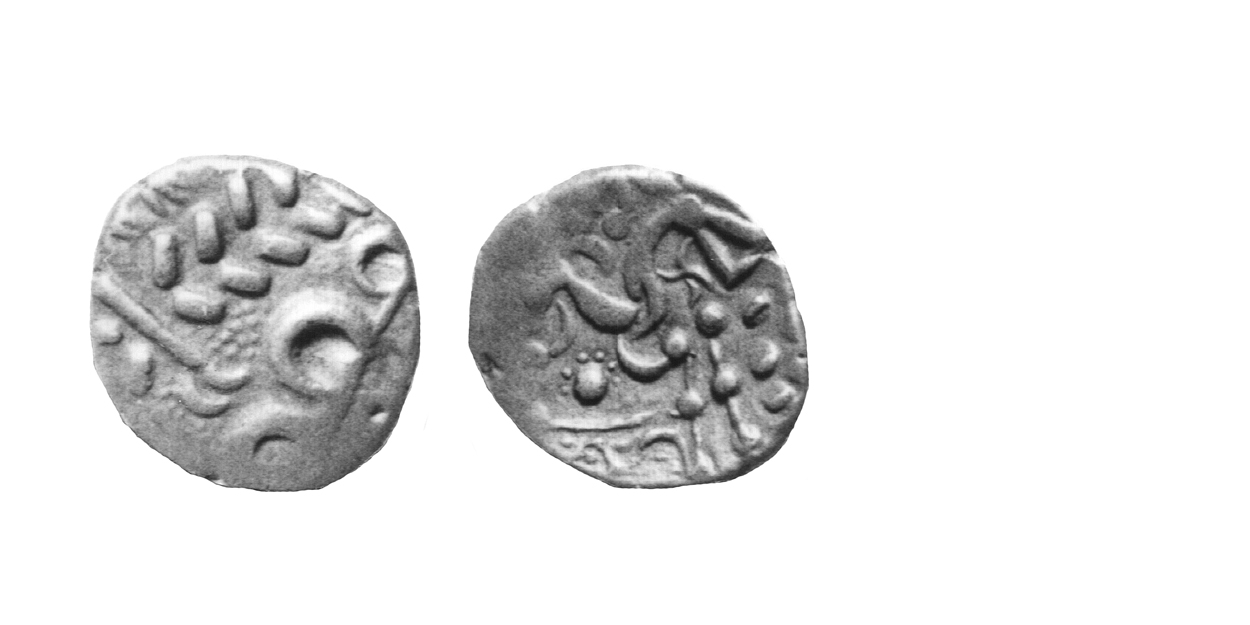
800 - 11 North East Coast Type
ca. 55 B.C. Rare
Gold Stater 5.7-6.4 gms. 18 mm
Earliest Record: Van Arsdell, 1989
OBV: Abstracted head of Apollo right
Identifying points:
1) as 800 - 07
REV: Disjointed horse right
Identifying points:
1) as 800 - 07, but has four-armed spiral below horse's neck
CLASSlFlCATlON: Corieltauvian A
NOTES:
- Most in museums
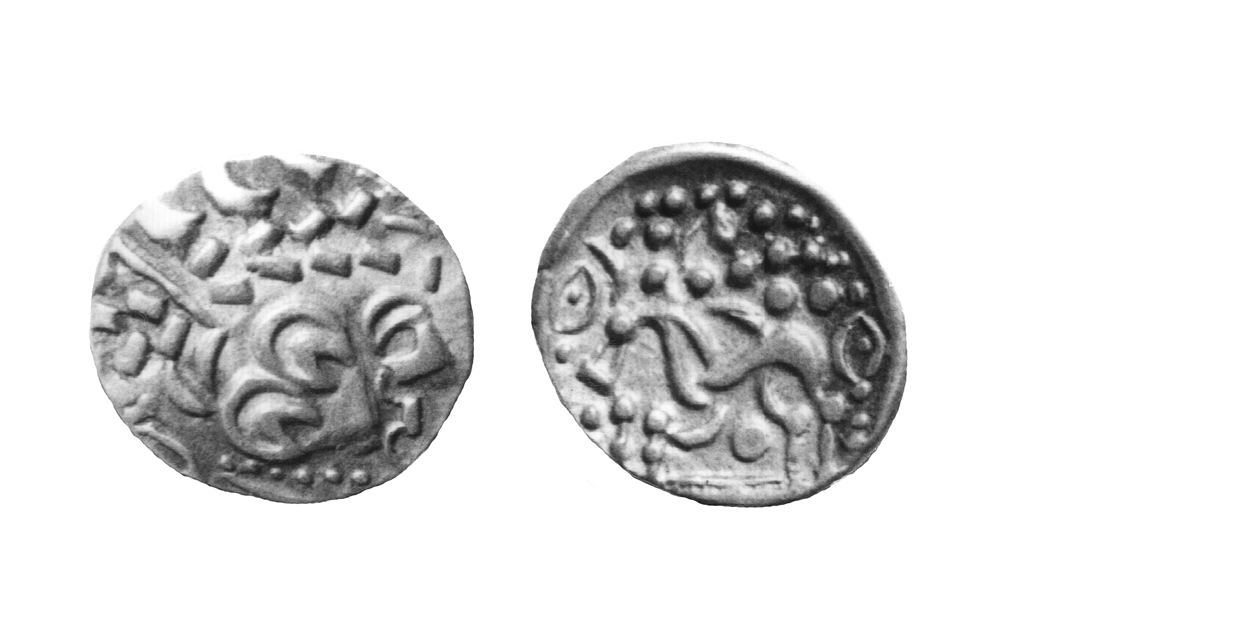
804 - 01 North East Coast Type
55-45 B.C. Very Rare
Gold Stater 5.6-6.1 gms. 22 mm
Earliest Record: Evans, 1864
OBV: Abstracted head of Apollo right
Identifying points:
1) spike with two crescents
2) curls oval-shaped, rather than crescents
3) wreath: leaves inwards
4) wreath leaves made up of small rectangles
REV: Disjointed horse left
Identifying points:
1) pellet below horse
2) horse's neck made Up of two curves
3) "coffee bean" behind and in front of horse
4) curved exergual lines with zig-zag-and-pellets pattern between
CLASSIFICATION: Corieltauvian B
NOTES:
- Many in museums
- Sometimes struck on a pronounced oval-shaped flan
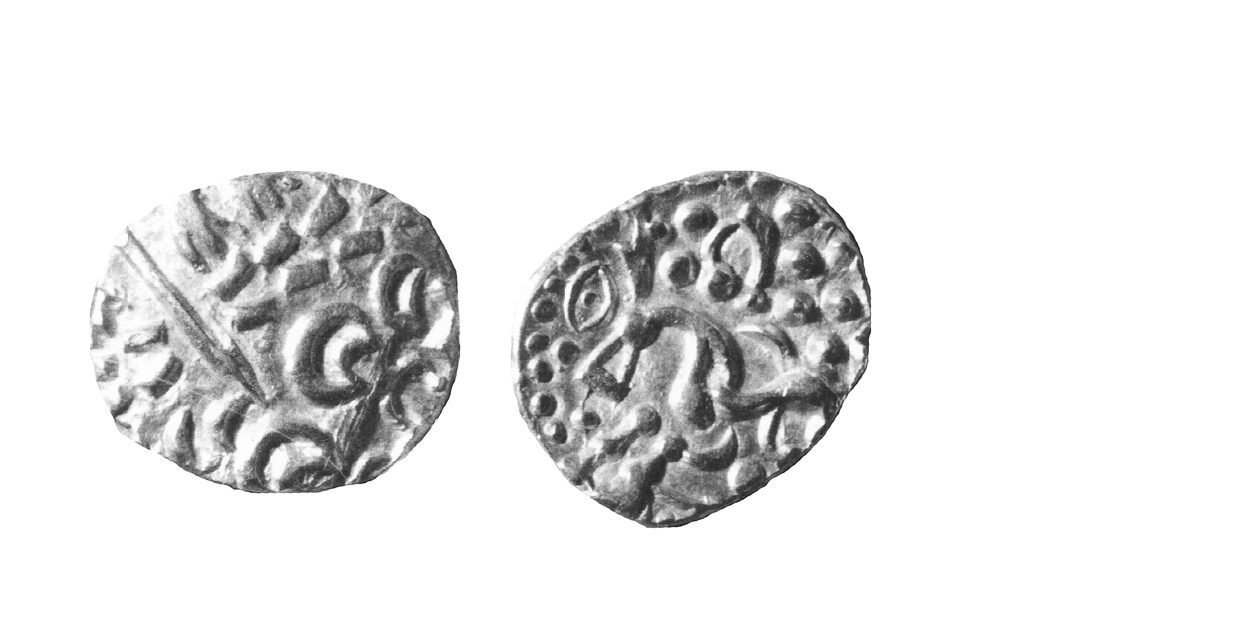
804 - 03 North East Coast Type
55-45 B.C. Rare
Gold Stater 5.6-6.1 gms. 20 mm
Earliest Record: Evans, 1864
OBV: Abstracted head of Apollo right
Identifying points:
1) spike with two crescents
2) diagonal linear depression to right of curls
3) curls almost circles, as opposed to crescents
4) stylized "yoke" to right of linear depression
5) wreath: leaves inwards
6) wreath leaves made up of larger rectangles than on 804 - 01
REV: Disjointed horse left
Identifying points:
1) Pellet below horse
2) horse's neck made up of two curves
3) "coffee bean" behind and in front of horse
4) two curved exergual lines with zig-zag-and-pellets pattern between
CLASSIFICATION: Corieltauvian B
NOTES:
- Many in museums
- Sometimes struck on a pronounced oval-shaped flan
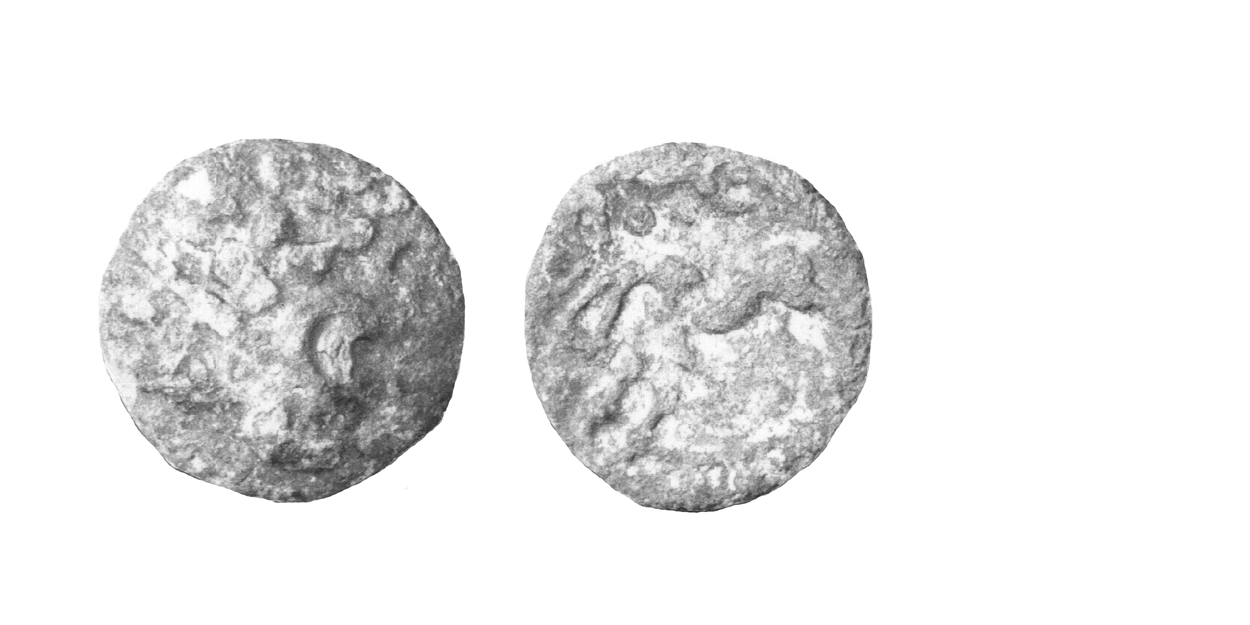
804 - 04 North East Coast Type
55-45 B.C. Extremely Rare
Gold/Bronze Plated Stater 4.9 gms. 19 mm
Earliest Record: Van Arsdell, 1989
OBV: Abstracted head of Apollo right
Identifying points:
1) as 804 - 03
REV: Disjointed horse right
Identifying points:
1) as 804 - 03
CLASSIFICATION: Corieltauvian B
NOTES:
- Ancient Forgery of 804 - 03
- Bronze core covered with gold foil or plated
- Possibly struck from "official" dies.
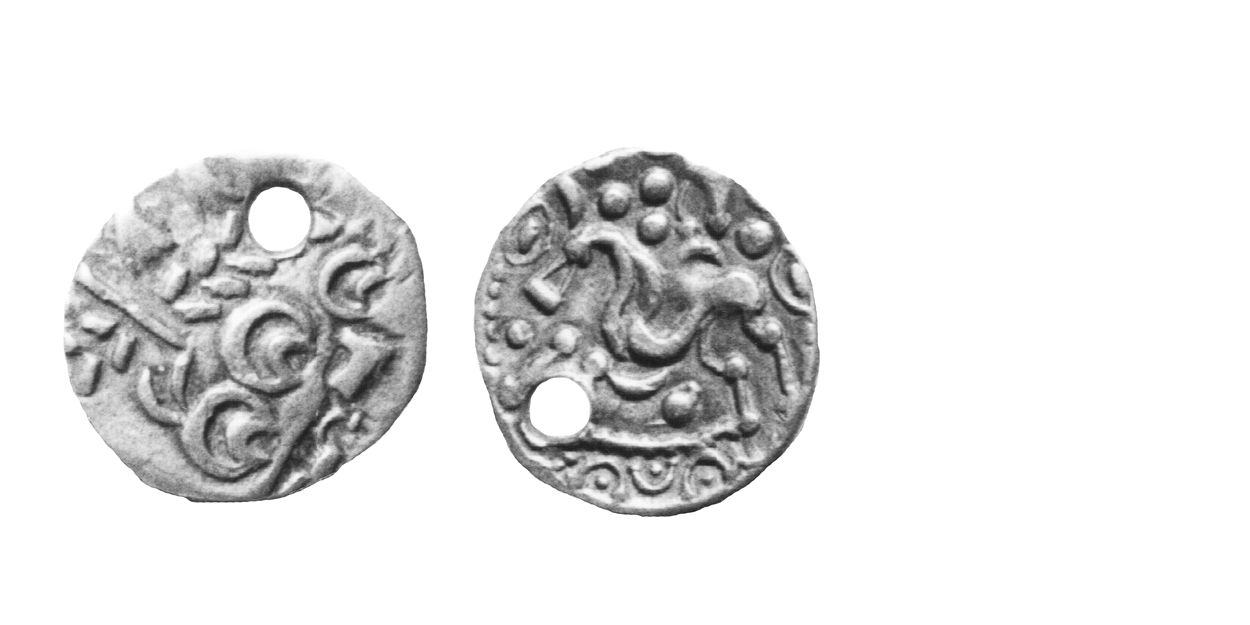
804 - 05 North East Coast Type
55-45 B.C. Extremely Rare
Gold Stater 5.6-6.1 gms. 18 mm
Earliest Record: Van Arsdell, 1989
OBV: Abstracted head of Apollo right
Identifying points:
1) spike with two crescents
2) diagonal linear depression to right of curls
3) curls almost circles, as opposed to crescents
4) stylized "yoke" to right of linear depression
5) wreath: leaves inwards
6) wreath leaves made up of small rectangles as on 804 - 01
REV: Disjointed horse left
Identifying points:
1) pellet below horse
2) horse's neck made up of two curves
3) "coffee bean" in front of horse
4) slightly curved exergual line
5) crescents-and-pellets motif below exergual line, instead of normal zig-zag-and-pellets
CLASSIFICATION: Corieltauvian B
NOTES:
- Recorded specimen in British Museum is holed
- Crescent-and-ring motif in exergue is likely copied from a Gallo-Belgic E Stater – see 52 - 01
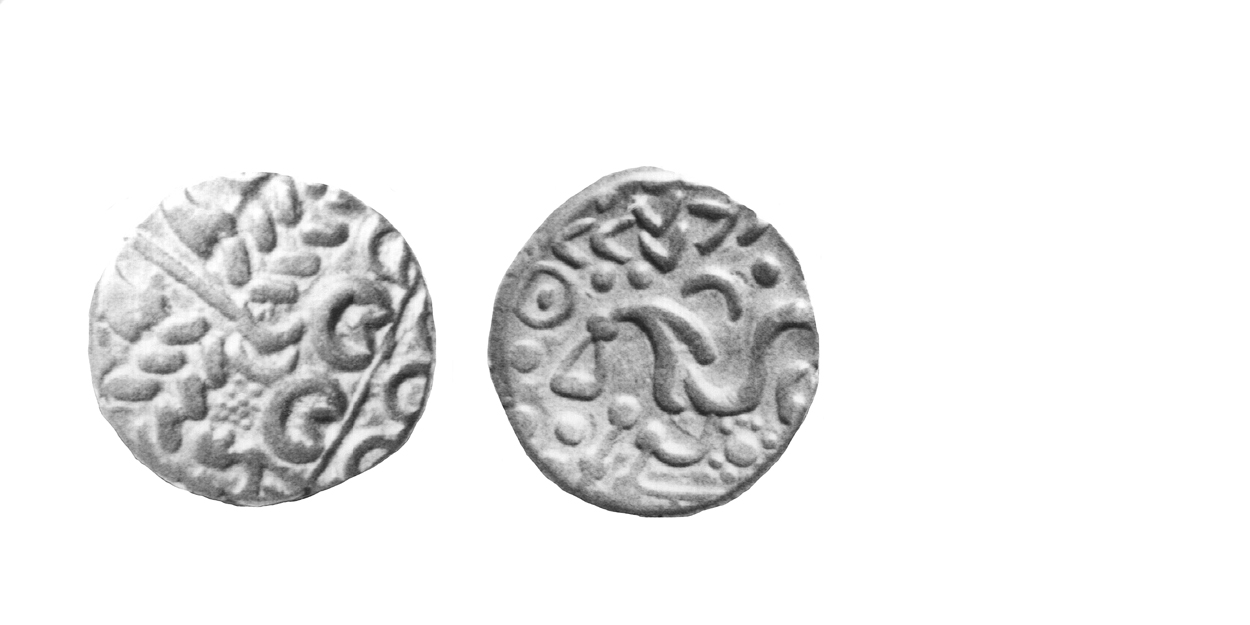
805 - 07 North East Coast Type
55-45 B.C. Extremely Rare
Gold Stater 5.6-6.1 gms. 18 mm
Earliest Record: Evans, 1890
OBV: Abstracted head of Apollo right
Identifying points:
1) spike with two crescents
2) diagonal linear depression to right of curls
3) stylized "yoke" to right of curls
4) curls almost circles as opposed to crescents
5) small pellets near crescents and spike
6) wreath: leaves inwards
REV: Disjointed horse left
Identifying points:
1) sunflower below horse
2) horse's neck made up of two curves
3) "coffee bean" in front of horse
4) stylized wreath-like motifs above horse
5) curved exergual line
CLASSIFICATION: Corieltauvian B
NOTES:
- Many in museums
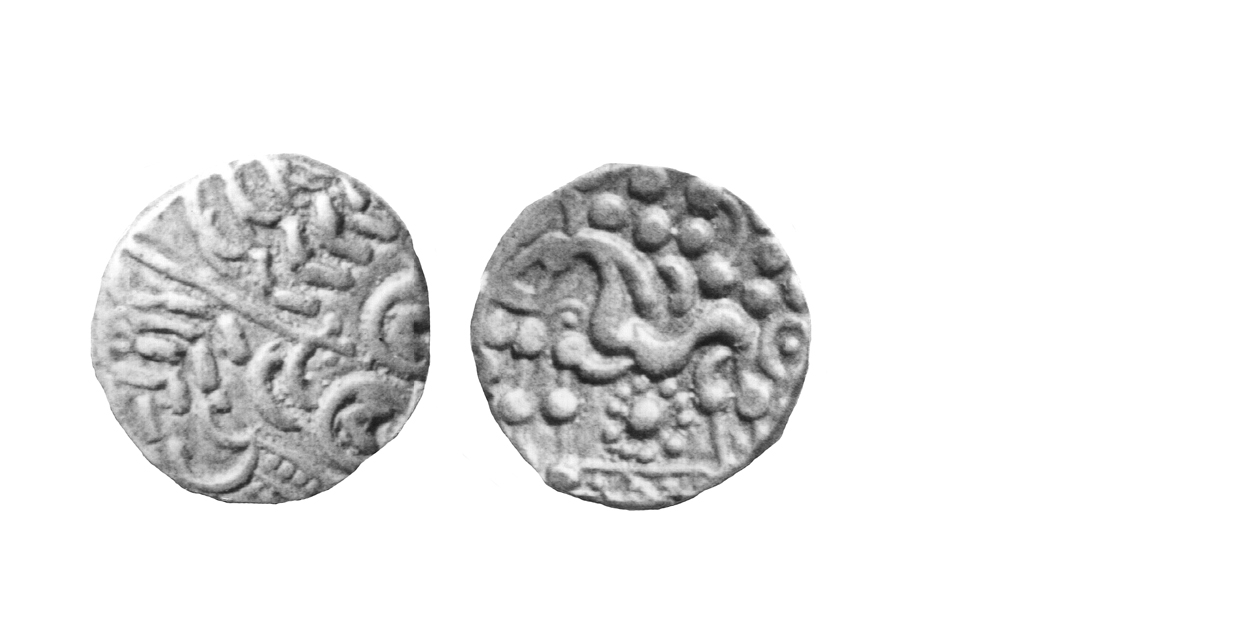
805 - 09 East Coast Type
55-45 B.C. Very Rare
Gold Stater 5.6 6.1 gms. 20 mm
Earliest Record: Evans, 1864
OBV: Abstracted head of Apollo right
Identifying points:
1) crude die-cutting compared to 805 - 07
2) "U"-shaped curls
3) crude "yoke", made up of rectangle and small crescents
REV: Disjointed horse left
Identifying points:
1) sunflower below horse made up of central pellet surrounded by large pellets as opposed to the usual small ones
2) two curves of horse's neck not well-distinguished, and may appear as one if the coin is lightly-struck
CLASSIFICATION: Corieltauvian B
NOTES:
- Many in museums
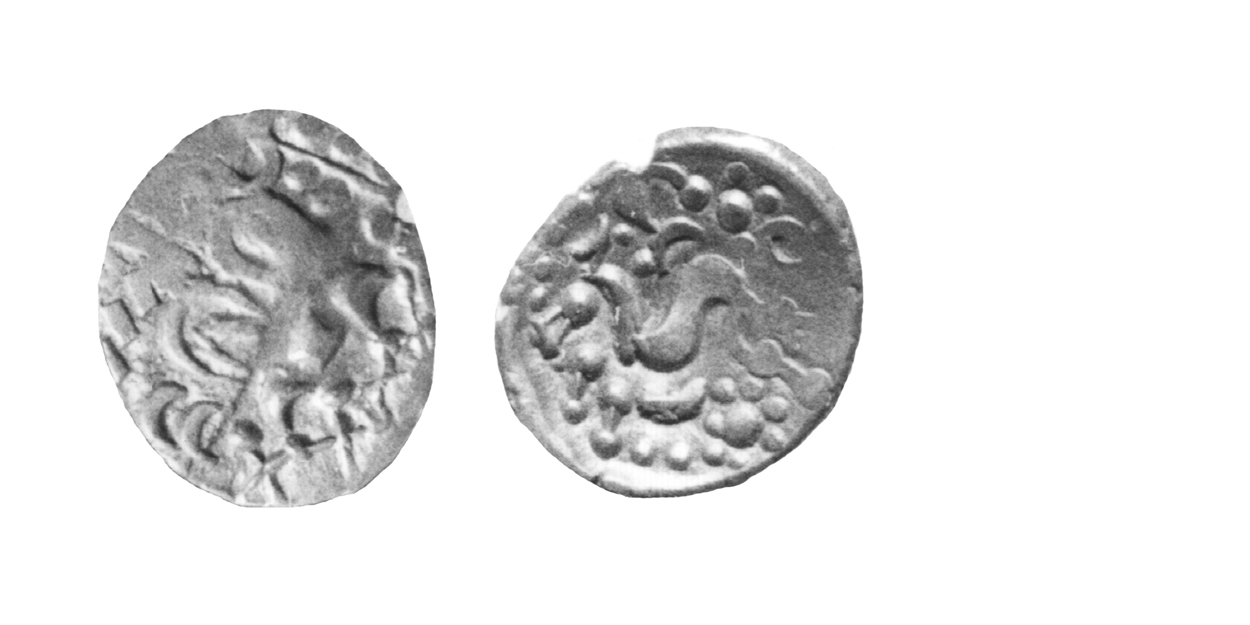
805 - 09 East Coast Type
55-45 B.C. Very Rare
Gold Stater 5.6 6.1 gms. 20 mm
Earliest Record: Evans, 1864
OBV: Abstracted head of Apollo right
Identifying points:
1) crude die-cutting compared to 805 - 07
2) "U"-shaped curls
3) crude "yoke", made up of rectangle and small crescents
REV: Disjointed horse left
Identifying points:
1) sunflower below horse made up of central pellet surrounded by large pellets as opposed to the usual small ones
2) two curves of horse's neck not well-distinguished, and may appear as one if the coin is lightly-struck
CLASSIFICATION: Corieltauvian B
NOTES:
- Many in museums
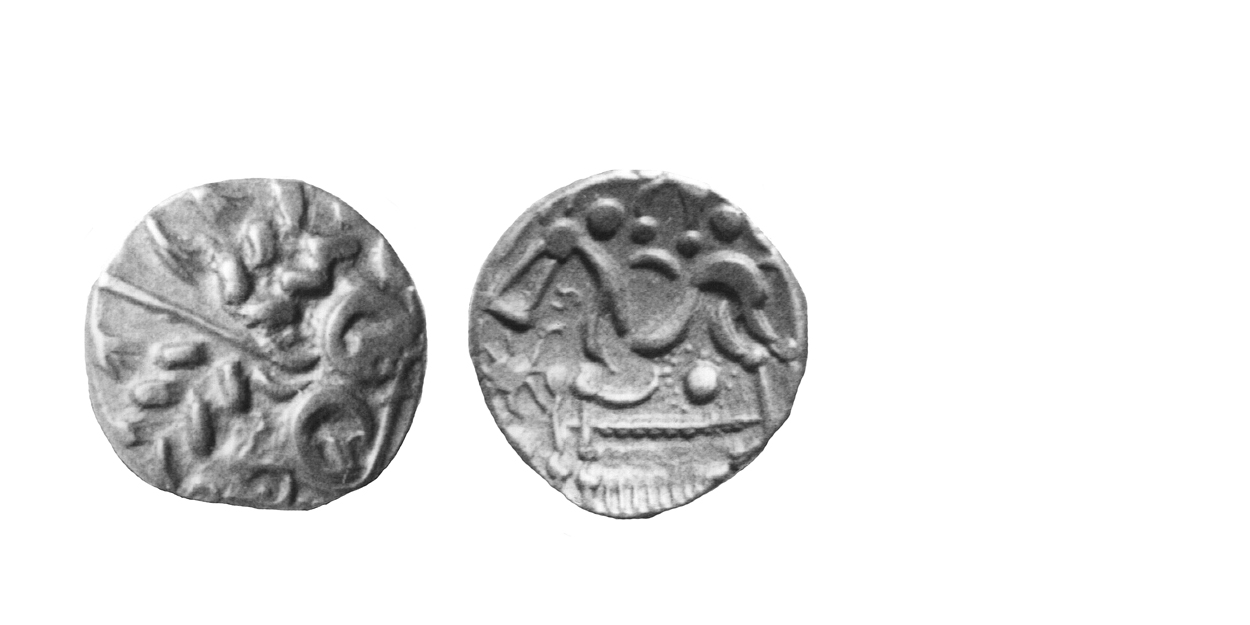
805 - 11 North East Coast Type
55-45 B.C. Common
Gold Stater 5.6-6.1 gms. 18 mm
Earliest Record: Evans, 1864
OBV: Abstracted head of Apollo right
Identifying points:
1) spike with two crescents
2) small pellets near crescents and spike
3) wreath: leaves inwards
REV: Disjointed horse left
Identifying points:
1) later-style horse as on 807 - 01
2) sunflower below horse
3) pellet with rays emanating from it in front of horse
4) two parallel exergual lines
5) vertical lines hang from lower exergual line
CLASSIFICATION: Corieltauvian B
NOTES:
- Many in museums
- Celtic Coin Index records now indicate this type is common
- Modern "Haslemere" forgery see 805 - 11F
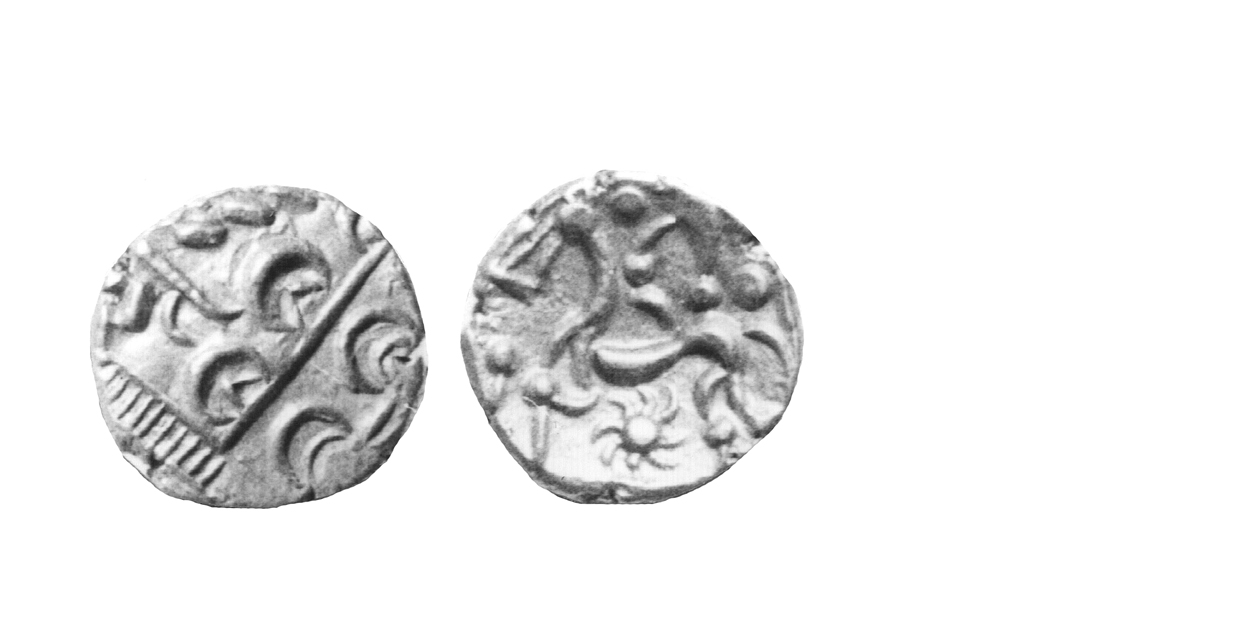
807 - 01 Transitional Type One
ca. 45 B.C. Extremely Rare
Gold Stater 5.6-6.1 gms. 17 mm
Earliest Record: Evans, 1890
OBV: Abstracted head of Apollo right
Identifying points:
1) spike with two crescents
2) diagonal linear depression with curls on either side
3) curls on right side of depression are combined with the stylized 'yoke'
4) short, parallel lines below curls run diagonally in same direction as linear depression
REV: Disjointed horse left
Identifying points:
1) later-style horse, as on 805 - 11
2) Wavy-armed spiral below horse
CLASSIFICATION: Corieltauvian B
NOTES:
- Existing example in museum
The Coinage of the Corieltauvi
The Corieltauvi occupied Lincolnshire, Leicestershire, Nottinghamshire, parts of Humberside and perhaps parts of Derbyshire and South Yorkshire. The correct name of the tribe, obtained from a tile-grafitto found in 1965, is CORIELTAUVI. In the past, the tribe had been known as the "Coritani", but the new spelling has been widely accepted. The Corieltauvi, for many years, were thought to be a largely peripheral tribe, untouched by the changes transforming southern Britain. This view has been questioned by archaeological studies made after 1960. They are now considered to have been an advanced group – early to adopt the potter's wheel, for example.
Recent studies indicate the coinage was one of the earliest struck in Britain, appearing shortly after the Atrebatic/Regnan/Belgic Westerham stater. The Corieltauvi struck coins continuously until the Claudian invasion or later. The coinage has a complex system of privy marks that may have been used for die control, weight specification or perhaps identification of metallurgical content.
The coinage was at one time thought to have a Brigantian origin because several large hoards were found in the territory of that tribe. However, more comprehensive analyses of findspots identify a primarily Corieltauvian source. Recently, assertions have been made that northerly finds of late types are Brigantian, but this is a case of over-interpretation of insufficient information. Given the fluid conditions after the Claudian Invasion, the location of the Corieltauvian mint may have shifted north. Similarly, the final resting places of the latest coins would naturally tend to be in the north. The possibility that the Brigantes struck some of the later types remains. But too little information exists at this time to prove a separate Brigantian coinage.
The coinage begins around 55 B.C. with the NORTH EAST COAST TYPE, derived stylistically from the Abstract Design Type staters of the Ambiani. These coins, struck to a standard weight of 6.25 grammes, appeared in two versions. The horse on the reverse faces either right or left, and previously it was felt the change signaled a difference in the weight of the two types. However, more recent weight studies show the difference is smaller than thought. In the current catalogue, the two are listed as a single issue. The NORTH EAST COAST TYPE was replaced about 45 B.C. by the SOUTH FERRIBY TYPE, signaling a significant weight reduction to 5.7 grammes.
The South Ferriby Type and its variations display the most complex series of privy marks found on any Ancient British coinage. Cleverly-made plated forgeries are known for most types. The forgeries were produced by hammering gold foil around a bronze core prior to striking, and some of the forgeries appear to be struck from official dies. The similarity between genuine and false coins, however, may only indicate the extent of technological knowledge amongst the tribal population – the forgers may have been as expert as the mint-workers in die-cutting. The proficiency of the forgers may help explain the need for complex privy marks on the genuine coins. Alternatively, future metallurgical studies may prove the marks signal changes in the gold/silver/copper relationship instead and thus serve as assay marks.
A long series of inscribed coins followed the uninscribed, and the coinage ended with the Roman suppression of tribal coinage during the fifties A.D.
Evidence of a Celtic mint has been discovered at Old Sleaford. However it is not known if it was the only Corieltauvian mint, nor if it was the mint producing all the coins listed in this catalogue.
Since the 1990's, a systematic study of Corieltauvian die-links has been performed by Geoffrey Cottam, who has published some of his findings. He has suggested that some of the coins may be local issues, and others may need later dating. It is possible that the chronology given here may need revision when Cottam's full analysis is published.
